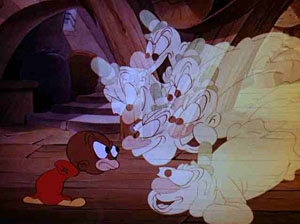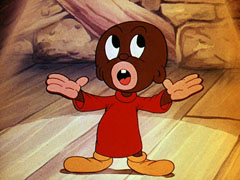
A Haunting We Will Go (1939) is the third and final cartoon starring Lil’ Eightball. It is different from the other two cartoons on a surface level. First, it is not part of the “Eightball” series but rather the “Cartune” series, which had been launched in 1934, “featuring Lil’ Eightball.” All of producer Walter Lantz’s cartoons for Universal Pictures after 1939 were “Cartunes;” when he briefly worked with United Artists in the 1940s, he did not bring the “Cartunes” name with him. Second, A Haunting We Will Go is the only Technicolor cartoon starring Eightball, because Lantz had recently stopped producing black-and-white films. Third, Eightball’s pet dog does not appear in this last episode.
 Otherwise, the elements are the same. Eightball sets about to disprove something, lectures in minstrel dialect and in long words with multiple syllables, gets caught in slapstick situations, and concedes defeat. This time, a young ghost tries to scare Eightball, but the protagonist refuses to believe in ghosts. The young ghost takes him to a nearby ghost-hideout, where other spirits join the young one in trying to scare Eightball. After a series of surreal gags, Eightball retreats in fright to his house.
Otherwise, the elements are the same. Eightball sets about to disprove something, lectures in minstrel dialect and in long words with multiple syllables, gets caught in slapstick situations, and concedes defeat. This time, a young ghost tries to scare Eightball, but the protagonist refuses to believe in ghosts. The young ghost takes him to a nearby ghost-hideout, where other spirits join the young one in trying to scare Eightball. After a series of surreal gags, Eightball retreats in fright to his house.
Concerning stereotypes, this episode plays with the old trope of the African American becoming bug-eyed and fearful when seeing a ghost, especially in a graveyard. The majority of the film’s length consists of Eightball not being scared of ghosts, and he does not show fear until well into the episode’s second half. Also, there is the usual grammatical correctness and formality (“Your confidence is commendable”) mixed in with crude dialect (“we childrens”). And of course, his eyes eventually do bug out, and his lips are sizable.
 The addition of Technicolor reveals some disturbing aspects of Eightball. The viewer now more clearly sees that Eightball spits when he talks. The spittle enhances the stereotype of the big lips, and Eightball himself draws attention to it by wiping the spittle from his lips with his sleeve. Speaking of clothes, Technicolor shows us that he only wears an oversized shirt and shoes. The scene in which he rides in an invisible car briefly shows his shirt flying above his legs. In that moment the viewer sees that Eightball not only wears no underwear but has no genitalia. Granted, the film is a product of the conservative Hays Era, in which filming of exposed genitalia was not allowed. Still, just as Hollywood desexualized African Americans with “sambo” and “mammy” characterizations, Lantz literally desexualized Eightball by making him a sambo-ish eunuch.
The addition of Technicolor reveals some disturbing aspects of Eightball. The viewer now more clearly sees that Eightball spits when he talks. The spittle enhances the stereotype of the big lips, and Eightball himself draws attention to it by wiping the spittle from his lips with his sleeve. Speaking of clothes, Technicolor shows us that he only wears an oversized shirt and shoes. The scene in which he rides in an invisible car briefly shows his shirt flying above his legs. In that moment the viewer sees that Eightball not only wears no underwear but has no genitalia. Granted, the film is a product of the conservative Hays Era, in which filming of exposed genitalia was not allowed. Still, just as Hollywood desexualized African Americans with “sambo” and “mammy” characterizations, Lantz literally desexualized Eightball by making him a sambo-ish eunuch.
By the release of this film, Lantz had a hit character with Andy Panda. When Eightball’s director Burt Gillett left the studio in 1939, Lantz retired the character. Hollywood was not quite finished with animated “sambo” figures, and producer George Pal’s character Jasper would achieve popularity in the 1940s. The failure of Eightball meant that audiences simply did not want a “sambo” figure that experimented with ethnic tropes; they just wanted the tropes.


 Christopher P. Lehman is a professor of ethnic studies at St. Cloud State University in St. Cloud, Minnesota. His books include American Animated Cartoons of the Vietnam Era and The Colored Cartoon, and he has been a visiting fellow at Harvard University.
Christopher P. Lehman is a professor of ethnic studies at St. Cloud State University in St. Cloud, Minnesota. His books include American Animated Cartoons of the Vietnam Era and The Colored Cartoon, and he has been a visiting fellow at Harvard University.



























Maybe it’s just me, but the ghosts and gags have at least a nodding acquaintance with Disney’s “Lonesome Ghosts”, also directed by Gillett.
Similar to how Jack Hannah made Fatso Bear for Lantz, which was just Disney’s Humphrey Bear in all but name and appearance.
Would you do George Pal’s “Jasper” next time?
This cartoon does resemble JASPER AND THE HAUNTED HOUSE, but I am always reminded of LONESOME GHOSTS more.
Can’t recall another cartoon where the transparent ghosts were able to pick up a mortal and wag him around.
I like the design of the little kid ghost – beats Casper any day. With his Pop and the other spirits, they have a lot of fun doing cartoony stuff that’s not necessarily scary, but just bizarro.
Too bad about racist handling of Eightball, there’s simply no way to ignore the ugly vibe in what could have been a pretty good cartoon.
Well, it seems as if all the major studios did their own “haunted house” cartoons with most of the film being taken up with characters’ bug-eyed reaction to ghosts; MGM had its version of Hugh Harman’s Bosko while Harman and Ising were still at the studio, and Warner Brothers had a kind of similar idea with “ANGEL PUSS” in which the black man does a series of double takes at the sight of what he thinks is the spirit of the drowned cat. Also, I was never always sure just who Mel Blanc is imitating when he does the “dialect”. In all the appearances of Eddie “Rochester” Anderson that I’d heard, Anderson does not mangle the English language. Even listen to Eddie Anderson voicing his own appearance in “THE MOUSE THAT JACK BUILT”. Yet, Mel Blanc falls back on the same voice characterization when he has to “perform”, figuratively, in blackface.
“Eightball not only wears no underwear but has no genitalia.”
Dat’s odd, dey usually gots LOTS of genitalia!!!
Go away.
Holy shit, I watched this as a kid on a crappy bootleg VHS with many other Walter Lantz shorts, but I eventually lost it and tried for SO LONG to find this particular cartoon again, I even inquired about it on many forums (and my description of it was quite close) but nobody knew it, you have no idea on how happy I am to finally have found it. The long search was mostly because I thought it was made by Disney, since the ghosts are pretty much a rip-off of the Lonesome Ghosts, and also because Disney was notorious for making racist characters in their early days, so I never bothered looking for it in the Walter Lantz filmography, I even looked on Fleischer’s but found nothing as well.